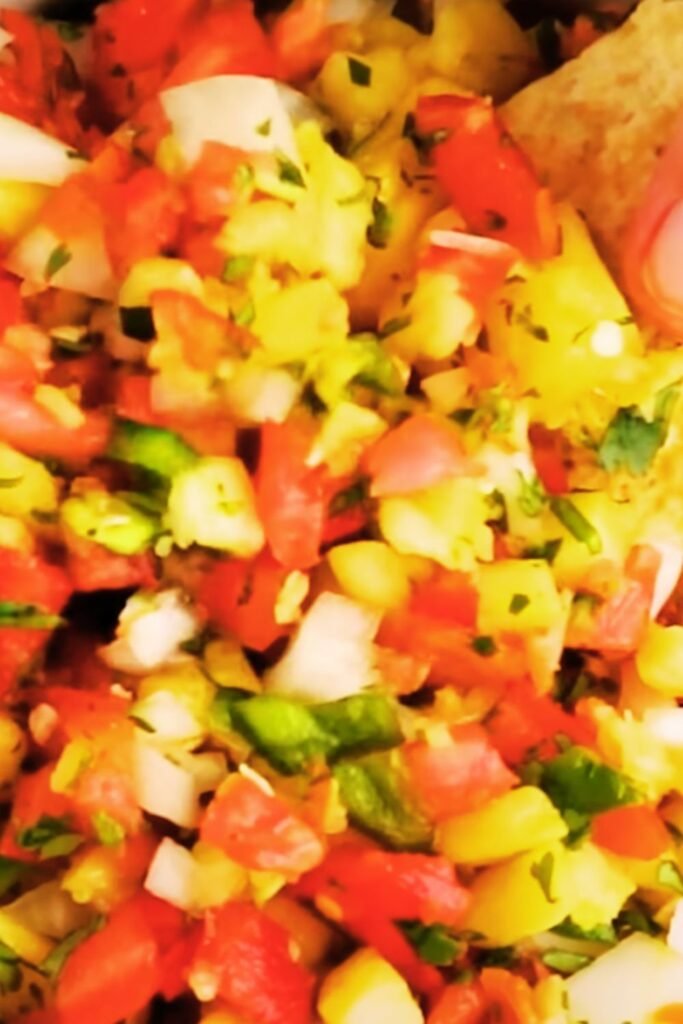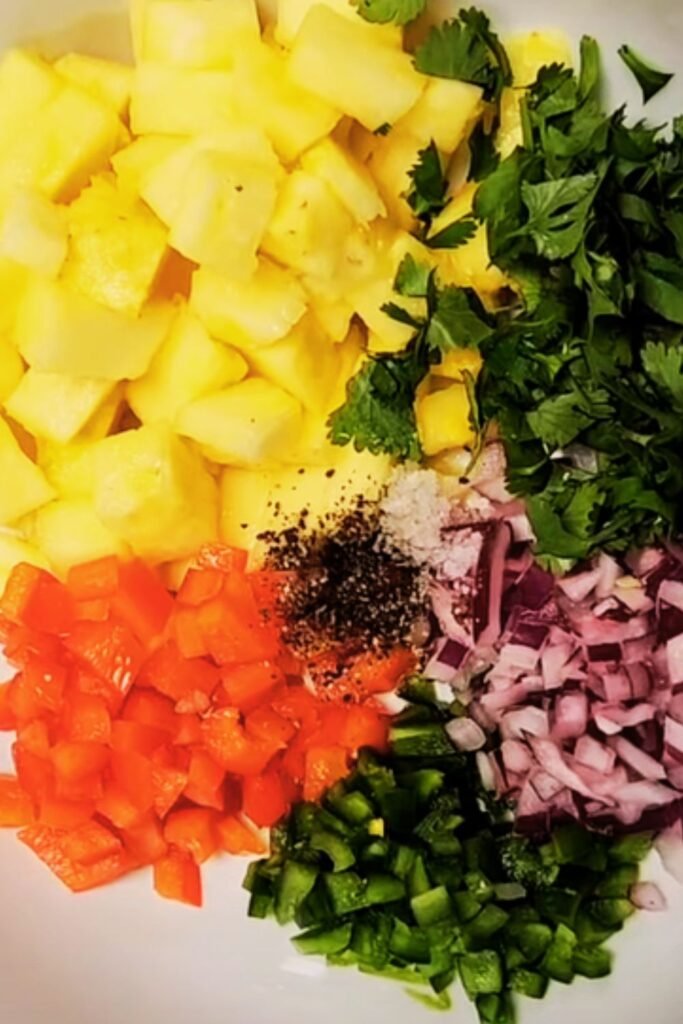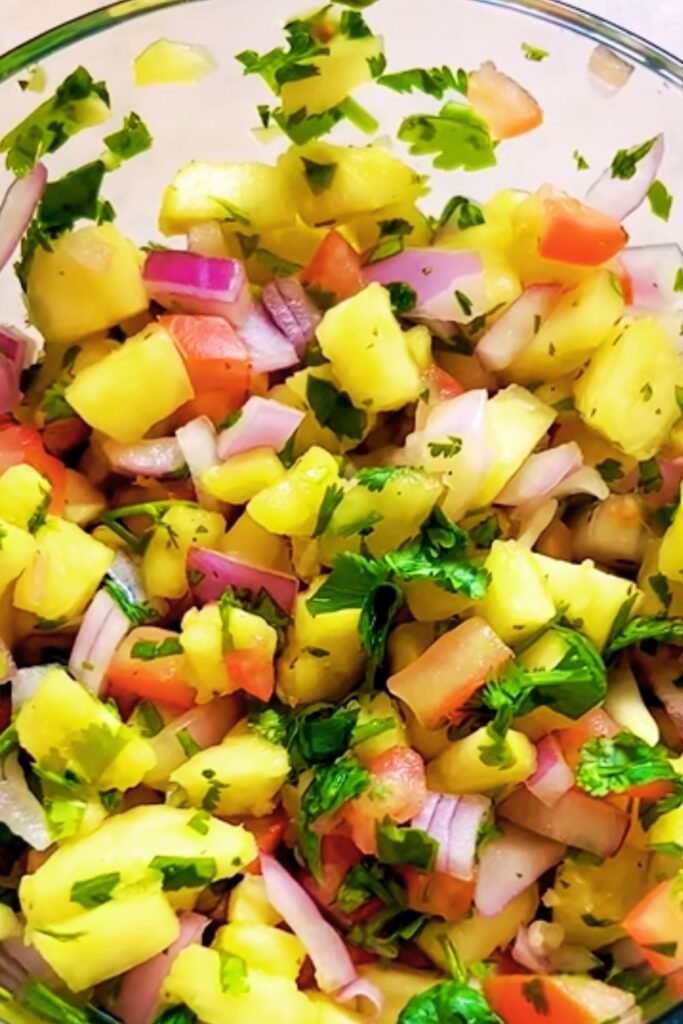There’s something magical about the first bite of pineapple salsa – that perfect balance of sweet, tangy, and spicy flavors dancing across your taste buds. I discovered this delightful concoction years ago during a beach vacation in Mexico, and I’ve been perfecting my recipe ever since. This isn’t just any salsa; it’s a vibrant celebration of tropical flavors that can transform an ordinary meal into something extraordinary.
What makes pineapple salsa so special is its versatility. It works beautifully as a dip with tortilla chips, but don’t stop there! I’ve found it elevates grilled fish, chicken, and pork to new heights. It can brighten up tacos, bring life to grain bowls, and even stand alone as a refreshing side dish on a hot summer day.
In this article, I’ll share my tried-and-true pineapple salsa recipe that’s been the star of countless backyard barbecues and family gatherings. I’ll walk you through each step, offer variations to suit your taste preferences, and provide tips for making this salsa truly shine. So grab your cutting board and let’s bring a taste of the tropics to your kitchen!
What Makes a Great Pineapple Salsa?
Before diving into the recipe, let’s talk about what makes pineapple salsa special. Unlike traditional tomato-based salsas, pineapple salsa offers:
- Sweet-heat balance: The natural sweetness of pineapple creates a perfect counterpoint to spicy jalapeños
- Textural contrast: Juicy pineapple chunks alongside crisp bell peppers and onions
- Bright, fresh flavor: Citrus notes and herbs that wake up your palate
- Versatility: Works as both a dip and a topping for various proteins
- Nutritional benefits: Packed with vitamin C, digestive enzymes, and antioxidants
The key to an outstanding pineapple salsa lies in using fresh, high-quality ingredients and finding the right balance between sweet, spicy, and tangy elements.
Essential Ingredients for Perfect Pineapple Salsa

The Star Player: Choosing the Perfect Pineapple
The foundation of great pineapple salsa is, of course, the pineapple itself. Here’s how to select one that’s perfectly ripe:
- Look for a pineapple with a golden-yellow exterior (some green is fine)
- The pineapple should yield slightly when gently squeezed
- Sniff the base – it should have a sweet, fragrant aroma
- The leaves should be fresh and green, not dried out or brown
- A heavier pineapple typically means it’s juicier
If you can only find underripe pineapples, don’t worry! Simply leave it at room temperature for 1-2 days until it develops a sweet smell and slight give when pressed.
While fresh pineapple is ideal, I understand that cutting one can be intimidating. In a pinch, you can use canned pineapple chunks (in juice, not syrup), but make sure to drain them thoroughly and pat dry with paper towels to prevent your salsa from becoming watery.
Supporting Cast: Fresh Produce & Herbs
What elevates pineapple salsa beyond a simple fruit dish is the careful selection of complementary ingredients:
Red Bell Pepper: Adds a sweet crunch and beautiful color contrast. You can substitute orange or yellow bell peppers, but I find red offers the perfect sweet-yet-vegetal note.
Red Onion: Provides a sharp, pungent counterpoint to the sweet pineapple. The vibrant purple color also makes the salsa visually appealing. Soak diced red onion in cold water for 10 minutes before adding to mellow its bite if preferred.
Jalapeño or Serrano Pepper: The heat element! Remove seeds and membranes for mild heat, or keep them for a spicier kick. I always recommend wearing gloves when handling hot peppers to prevent the oils from burning your skin.
Fresh Cilantro: This herb brings that distinctive fresh, citrusy flavor that’s essential to good salsa. If you’re one of those people with the “cilantro tastes like soap” gene, substitute with fresh mint or a combination of parsley and a touch of oregano.
Lime: Both the juice and zest brighten all the flavors and add necessary acidity. Always use fresh limes, never bottled juice – the difference is remarkable.
Complete Recipe
Now that we understand our ingredients, let’s put everything together in a recipe that serves 6-8 people as an appetizer.
Ingredients:
- 1 medium ripe pineapple (about 3-4 cups when diced)
- 1 medium red bell pepper
- 1/2 medium red onion
- 1-2 jalapeño or serrano peppers (depending on heat preference)
- 1/2 cup fresh cilantro leaves
- 2 limes (juice and zest)
- 1 tablespoon extra virgin olive oil
- 1/2 teaspoon sea salt (plus more to taste)
- 1/4 teaspoon freshly ground black pepper
- Optional additions: 1 diced avocado, 1 minced garlic clove, 1/4 teaspoon ground cumin
Equipment:
- Sharp chef’s knife
- Cutting board
- Mixing bowl
- Citrus zester/microplane
- Citrus juicer (optional)
- Airtight container for storage
Instructions:
- Prepare the pineapple: Cut off the top and bottom of the pineapple. Stand it upright and slice off the outer skin, making sure to remove the “eyes” (the small brown spots). Cut the pineapple into quarters lengthwise, remove the core, and then dice into small chunks about 1/4 to 1/2 inch in size.
- Dice the vegetables: Finely dice the red bell pepper and red onion into pieces similar in size to the pineapple chunks. For the jalapeño, remove the stem, and depending on your heat preference, either remove or keep the seeds and membranes before mincing finely.
- Prepare the cilantro and lime: Chop the cilantro leaves, zest one lime, and juice both limes.
- Combine all ingredients: In a large mixing bowl, combine the diced pineapple, bell pepper, red onion, and jalapeño. Add the chopped cilantro, lime zest, lime juice, olive oil, salt, and pepper.
- Mix and marinate: Gently toss all ingredients until well combined. Taste and adjust seasoning as needed, adding more salt, pepper, or lime juice to balance the flavors.
- Let flavors meld: For best results, cover the bowl and refrigerate for at least 30 minutes (or up to 4 hours) before serving to allow the flavors to meld together.
- Serve: Bring to room temperature for about 15 minutes before serving for optimal flavor.
Nutritional Information
| Nutrient | Amount per Serving (1/2 cup) |
|---|---|
| Calories | 65 |
| Total Fat | 1.8g |
| Saturated Fat | 0.2g |
| Cholesterol | 0mg |
| Sodium | 150mg |
| Total Carbohydrates | 12g |
| Dietary Fiber | 1.5g |
| Sugars | 8g |
| Protein | 0.6g |
| Vitamin C | 80% DV |
| Vitamin A | 15% DV |
| Potassium | 5% DV |
Note: Nutritional values are approximate and will vary based on exact ingredients and portions.
Tips for the Perfect Pineapple Salsa
I’ve made this salsa hundreds of times, and over the years I’ve collected some tips that make a significant difference:
Texture Matters
The size of your dice can dramatically impact the eating experience. For a dip, I prefer smaller pieces (about 1/4 inch) that easily scoop onto chips. For a topping for grilled meats or fish, slightly larger chunks (about 1/2 inch) create more textural interest and hold up better to the heat of cooked foods.
Balance is Key
Pineapple salsa should have a balanced sweet-sour-spicy profile. If your pineapple is very sweet, you might need more lime juice to balance it. If it’s less sweet, you might want to reduce the jalapeño or add a tiny drizzle of honey to find that perfect equilibrium.
The Waiting Game
While you can certainly enjoy this salsa immediately after making it, I find that letting it rest for at least 30 minutes allows the flavors to meld beautifully. The salt draws out juices from the vegetables and fruit, and the lime juice slightly “cooks” and softens the ingredients. However, don’t wait too long – after about 24 hours, the salsa starts to lose its bright, fresh quality.
Storage Solutions

Pineapple salsa is best consumed within 2-3 days of making it. Store it in an airtight container in the refrigerator. I find that placing a paper towel on top before sealing can absorb excess moisture and keep the salsa fresher longer.
If you notice the salsa becoming watery after storage, simply drain off the excess liquid before serving, or use a slotted spoon to serve. A quick stir and a squeeze of fresh lime juice can revive day-old salsa nicely.
Serving Suggestions & Pairings
Pineapple salsa is incredibly versatile. Here are my favorite ways to use it:
As a Dip
Serve with blue corn tortilla chips for a visually stunning appetizer. The earthiness of blue corn pairs beautifully with the bright, tropical flavors.
With Seafood
- Spoon over grilled mahi-mahi or salmon
- Serve alongside seared scallops
- Use as a topping for fish tacos
- Mix into shrimp ceviche for an extra flavor dimension
With Poultry and Meat
- Serve with jerk chicken for a Caribbean-inspired meal
- Use as a topping for grilled chicken breast
- Spoon over pulled pork tacos
- Serve alongside grilled pork chops
Vegetarian Applications
- Top black bean burgers
- Serve with grilled halloumi cheese
- Mix into cooked quinoa for a refreshing grain salad
- Use as a filling component in vegetable wraps
Complete Meal Ideas
Tropical Fish Dinner:
- Grilled mahi-mahi with pineapple salsa
- Coconut rice
- Quick sautéed greens with garlic
Taco Night:
- Soft corn tortillas
- Seasoned black beans or grilled chicken
- Pineapple salsa
- Avocado slices
- Lime crema
Summer Grain Bowl:
- Quinoa base
- Roasted sweet potatoes
- Avocado
- Pineapple salsa
- Toasted pepitas
Variations to Try

The basic pineapple salsa recipe is just the beginning. Here are some of my favorite variations that maintain the essence of pineapple salsa while introducing new flavor dimensions:
Tropical Fusion
Add 1 diced mango and 1/4 cup toasted coconut flakes for an even more tropical flavor profile. This version pairs exceptionally well with grilled fish.
Smoky Pineapple Salsa
Grill pineapple chunks before dicing them, and add 1/2 teaspoon of smoked paprika or 1 finely diced chipotle pepper in adobo sauce. The smoky element adds wonderful depth and complexity.
Asian-Inspired
Replace the cilantro with fresh mint and basil, add 1 tablespoon of finely minced ginger, and substitute rice vinegar for half of the lime juice. A splash of fish sauce (just 1/2 teaspoon) adds remarkable umami depth. This version is wonderful with grilled chicken satay.
Mediterranean Twist
Add 1/2 cup diced cucumber, 1/4 cup crumbled feta cheese, and substitute fresh oregano for half of the cilantro. This version works beautifully as a side dish for grilled lamb.
Avocado Pineapple Salsa
Add 1 diced avocado just before serving for creaminess that balances the acidic elements beautifully. The healthy fats in avocado also make this version more satisfying as a light lunch when served with chips.
Seasonal Adaptations
While pineapple is available year-round in most supermarkets, you might want to adapt this recipe seasonally:
Summer Version
When stone fruits are abundant, try replacing half the pineapple with diced peaches or nectarines for a subtle variation that makes use of peak-season produce.
Fall Twist
Add small dices of firm pear and a sprinkle of pomegranate seeds for a autumnal interpretation that pairs wonderfully with pork dishes.
Winter Brightener
During citrus season, add segments of blood orange or cara cara oranges for a vitamin C boost and beautiful color. This version brings welcome brightness to winter meals.
Spring Fresh
Add diced strawberries and a handful of microgreens for a springtime variation that works beautifully as a topping for grilled salmon.
The Health Benefits of Pineapple Salsa
Beyond being delicious, pineapple salsa offers impressive nutritional benefits:
Digestive Aid
Pineapple contains bromelain, an enzyme that helps break down proteins and can aid digestion. This makes pineapple salsa an excellent accompaniment to protein-heavy meals.
Immune Support
The high vitamin C content from pineapple, bell peppers, and lime juice supports immune function – a single serving can provide nearly a full day’s recommended vitamin C intake.
Anti-inflammatory Properties
Bromelain also has anti-inflammatory properties, while the capsaicin in jalapeños can help reduce inflammation and boost metabolism.
Low in Calories, High in Nutrients
With its high water content and fiber, pineapple salsa offers tremendous flavor with relatively few calories, making it a nutrient-dense choice for those monitoring calorie intake.
Troubleshooting Common Issues
Even with a simple recipe like pineapple salsa, things can sometimes go awry. Here are solutions to common problems:
Too Watery Salsa
Problem: Your salsa has released too much liquid and looks soupy. Solution: Drain excess liquid through a fine-mesh strainer, or serve with a slotted spoon. To prevent this issue, make sure to thoroughly drain canned pineapple if using, and consider salting and draining your diced red onions for 10 minutes before mixing them in.
Too Spicy
Problem: The heat level is overwhelming. Solution: Add more diced pineapple to dilute the heat, or incorporate diced avocado, which helps neutralize capsaicin. A dollop of Greek yogurt served alongside can also help tame the flames.
Too Sweet
Problem: The salsa lacks balance and tastes overly sweet. Solution: Add more lime juice and a pinch of salt to counteract the sweetness. In extreme cases, a tiny splash of vinegar (white or apple cider) can help balance excessive sweetness.
Bitter Aftertaste
Problem: There’s an unpleasant bitter note. Solution: This often comes from pith (white part) in the lime zest or from the cilantro stems. Be careful to zest only the green part of limes, and use only cilantro leaves, discarding tough stems.
Questions & Answers
Q: Can I make pineapple salsa ahead of time for a party?
Yes, you can make it up to 24 hours in advance, though it’s best within 4-6 hours of preparation. Store it covered in the refrigerator and give it a good stir before serving. If making far in advance, consider adding the cilantro just before serving to maintain its bright color and flavor.
Q: Is pineapple salsa spicy?
It can be as mild or spicy as you like! The beauty of making your own is controlling the heat level. For mild salsa, use just half a jalapeño with seeds and membranes removed. For medium heat, use a whole jalapeño with some seeds. For spicy salsa, use 1-2 jalapeños or switch to serrano peppers and keep some of the seeds.
Q: Can I use canned pineapple if fresh isn’t available?
Absolutely. While fresh pineapple provides the best texture and flavor, canned pineapple chunks in juice (not syrup) work well in a pinch. Be sure to drain thoroughly and pat dry with paper towels to prevent watery salsa. Frozen pineapple that’s been thawed and drained can also work, though the texture will be slightly softer.
Q: How long does pineapple salsa last in the refrigerator?
Properly stored in an airtight container, pineapple salsa will keep for 2-3 days in the refrigerator. After that, while still safe to eat, the texture begins to deteriorate as the pineapple releases more juice and the vegetables soften.
Q: Can I freeze pineapple salsa?
I don’t recommend freezing pineapple salsa. The high water content in the ingredients means that freezing and thawing will result in a mushy texture and diluted flavors. It’s best enjoyed fresh or within a few days of making.
Q: I’m allergic to cilantro/don’t like cilantro. What can I substitute?
Fresh mint makes an excellent substitute, offering a different but equally refreshing flavor profile. A combination of fresh parsley and a small amount of basil or oregano can also work well. For those who find cilantro soapy-tasting due to genetic factors, these alternatives provide a completely different flavor experience.
Q: Can this recipe be canned for longer storage?
This fresh salsa recipe is not suitable for canning due to its low acidity level, which could make it unsafe for shelf-stable preservation. If you’re interested in preserving pineapple salsa, you would need to follow a recipe specifically developed for canning that includes sufficient acid (usually in the form of vinegar) to make it food-safe.
Q: What makes pineapple salsa different from regular tomato salsa?
The primary difference is the base fruit – pineapple instead of tomatoes creates a sweeter profile. Pineapple salsa also tends to be chunkier in texture and often incorporates fewer ingredients than traditional Mexican salsas. The flavor profile leans tropical rather than purely savory, making it especially complementary to seafood and grilled meats.
Conclusion
Pineapple salsa represents everything I love about cooking – it’s simple yet impressive, adaptable to countless variations, and brings together contrasting flavors and textures in perfect harmony. It’s the kind of recipe that feels special enough for entertaining but is easy enough for everyday meals.
I encourage you to think of this recipe as a starting point. Once you’ve mastered the basic version, begin experimenting with different heat levels, additional fruits, or complementary herbs. Make it your own, and don’t be afraid to adjust based on what looks freshest at the market or what you’re serving it with.
The joy of cooking comes from sharing delicious food with others, and this vibrant pineapple salsa is guaranteed to bring smiles to the table. Whether scooped onto a tortilla chip, spooned over grilled fish, or enjoyed as a refreshing side dish, it adds a burst of tropical sunshine to any meal.
So grab a ripe pineapple, sharpen your knife, and get chopping – a little effort yields big flavor rewards with this versatile recipe!